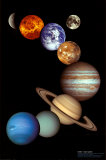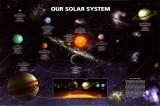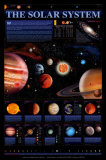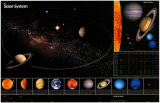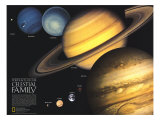|
|
Solar System Educational Astronomy Posters
teaching resources for the science and social studies classrooms, and home schoolers.
|
science > astronomy > SOLAR SYSTEM
|
The Solar System is the orbiting planets, asteroids, meteroroids, comets and dust bound by gravity to our Sun. The Solar System is located in the Milky Way Galaxy of the Universe. Other systems of objects orbiting central stars are known as planetary systems. Our solar system has eight major planets - in order from the Sun: Mercury, Venus, Earth, Mars, Jupiter, Saturn, Uranus, Neptune and Pluto. The first four "inner planets" are terrestrial, the outer four planets are “gas giants”. There is also an asteroid belt orbiting the Sun as well as objects such as Halley's Comet.
|
|
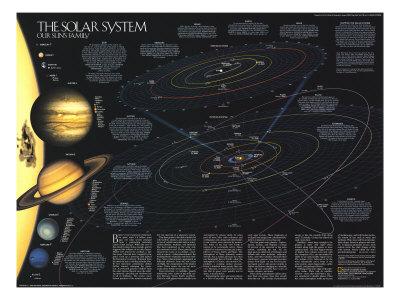
Solar System Map,
1990, Giclee Print
Nat'l Geo. Soc. 1990
Born in the darkness of interstellar space some 4.6 billion years ago, our solar system emerged from a contracting molecular cloud of dust and gas. When the core of this cloud became dense enough, gravity triggered the collapse of its inner layers. Matter fell inward for perhaps a million years. Internal heat, trapped by the gases, fired up a protosun and ignited thermonuclear reactions. Rotation drew the material into a swirling nebular disk. Its hot innermost constituents drifted farther inward, enlarging the protosun. A powerful gaseous outflow from the solar inferno blasted away the infalling material, unveiling our newborn sun in all its billiance. The cooler, more distant portions of the nebula contained the raw material of a planetary system.
|
|
|
| Montage of planetary images taken by spacecraft managed by the Jet Propulsion Laboratory in Pasadena, CA. From top to bottom - Mercury, Venus, Earth (and Moon), Mars, Jupiter, Saturn, Uranus and Neptune. The image of Mercury was taken by Mariner 10, Venus was taken by Magellan, Earth and Moon were taken by Galileo, Mars was taken by Mars Global Surveyor, Jupiter was taken by Cassini, Saturn, Uranus and Neptune were taken by Voyager. Inner planets (Mercury, Venus, Earth with Moon, and Mars) are roughly to scale to each other; the outer planets (Jupiter, Saturn, Uranus, and Neptune) are roughly to scale to each other. |
|
Tiny dust grains in the disk consisted of solid carbon, silicates, and metals as well as ices of volatile materials such as water, carbon dioxide, methane, and ammonia that had condensed as the solar nebula continue to cool. These particles coalesced into rocky or icy clumps – asteroids or comets – called planetesimals, the building blocks of planets and their satellites. Since planetesimals aggregated at different distance from the sun's heat and light, the composition of the planets varies. Those nearer the sun are more rocky, those farther away are more icy.
Four terrestrial, or earthlike, planets inhabit the inner realm of the solar system: Mercury, Venus, Earth, and Mars. Each is a solid sphere with a metallic core surrounded by silicate shells. In times past all were alive with volcanoes and earthquakes and, along with other bodies in our system, were cratered by meteorites; today of the four only Earth is known to be tectonically active. Gases exhaled by volcanoes became the atmospheres of Venus, Earth, and Mars. The atmosphere of Mars, primarily carbon dioxide, has a surface pressure less than one-hundredth that of Earth, while the atmosphere of Venus, also mostly CO2, produes a crushing surface pressure nearly a hundred times greater than our own. Mercury, so small and close to the sun that its gases were quickly lost to space, is nearly airless.
Separating the inner and outer planets is a belt of asteroids, flotsam from the early solar system. These fragments of rock and iron range from a thousand kilometers in diameter to less than one.
The four giant outer planets – Jupiter, Saturn, Uranus, and Neptune – contain 99 percent of the material in the solar system, excluding the sun, all are huge gaseous spheroids of hydrogen and helium with some methane, ammonia, water, and other volatiles. Beneath their cloud layers, gaseous hydrogen becomes denser with depth – at one level becoming liquid and still greater depths in Jupiter and Saturn changing into a metallic state. All four probably have cores of metals, silicates, and water.
Three of the giant planets radiate more heat back into space than they absorb from the sun. This residue of primordial energy is like warmth from dying coals. Curiously, Uranus has almost no such excess heat.
Satellites – some large enough to be planets in their own right – either formed along with the giants or were captured later. The four biggest moons of Jupiter have silicate cores and, with the exception of Io, are surrounded by shells of ice and possibly liquid water. The surface of Io, believed to be the most volcanically active body in the solar system, spurts liquid sulfur, sulfur dioxide, and perhaps silicates.
Orbiting at the outer edge of the planetary realm, Pluto and its satellite, Charon – more than half Pluto's size – are considered a double planet. Pluto has a thin atmosphere made up in part of methane gas, and both bodies probably consist of ices such as water and methane. Pluto may well be an intermediate object between planets and comets. Composed primarily of ices, most comets circle the dark fringes of the solar system, barely with the sun's gravitational grasp.
|
• “Outside intelligences, exploring the solar system with true impartiality, would be quite likely to enter the sun in their records thus: Star X, spectral class G0, 4 planets plus debris.” ~ Isaac Asimov
• “In the new wilderness of the Solar System may lie the future preservation of mankind.” ~ Arthur C. Clarke
• “I can well appreciate, Holy Father, that as soon as certain people realise that in these books which I have written about the Revolutions of the spheres of the universe I attribute certain motions to the globe of the Earth, they will at once clamour for me to be hooted off the stage with such an opinion.” ~ Copernicus
• “The Earth is just too small and fragile a basket for the human race to keep all its eggs in.” ~ Robert Heinlein
• “Eventually we must leave Earth – at least a certain number of our progeny must as our sun approaches the end of its solar life cycle. But just as terrestrial explorers have always led the way for settlers, this will also happen extraterrestrially. Earth is our cradle, not our final destiny.” Astronaut Edgar Mitchell, The Way of the Explorer, 1996
• “The use of solar energy has not been opened up because the oil industry does not own the sun.” Ralph Nadar
• “In some remote corner of the universe, poured out and glittering in innumerable solar systems, there once was a star on which clever animals invented knowledge.” ~ Friedrich Nietzsche
• “Man must at all costs overcome the Earth's gravity and have, in reserve, the space at least of the Solar System.” ~ Konstantin Tsiolkovsky
• “In spite of the opinions of certain narrow-minded people, who would shut up the human race upon this globe, as within some magic circle which it must never outstep, we shall one day travel to the moon, the planets, and the stars, with the same facility, rapidity, and certainty as we now make the voyage from Liverpool to New York.” ~ Jules Verne
|
|
|
Our Solar System lies on one of the outer arms of the Milky Way, thirty thousand light years from the galatic center. ...
|
|
|
|
|
|
|
|
|
|
Solar System NASA
1 Sun + 9 Planets + 57 Moons + 10,000 Asteroids + 100 Billion Comets
|
|
|
|
Montage of planetary images taken by spacecraft managed by the Jet Propulsion Laboratory in Pasadena, CA. From top to bottom - Mercury, Venus, Earth (and Moon), Mars, Jupiter, Saturn, Uranus and Neptune. The image of Mercury was taken by Mariner 10, Venus was taken by Magellan, Earth and Moon were taken by Galileo, Mars was taken by Mars Global Surveyor, Jupiter was taken by Cassini, Saturn, Uranus and Neptune were taken by Voyager. Inner planets (Mercury, Venus, Earth with Moon, and Mars) are roughly to scale to each other; the outer planets (Jupiter, Saturn, Uranus, and Neptune) are roughly to scale to each other. Image courtesy of Jet Propulsion Laboratory.
• more planets posters
|
|
|
|
|
|
|
Portrait of Our Celestial Family -
So varied are the faces in this protrait gallery of planets that it is hard to image they belong to the same family. Yet family they are – born of common cosmic materials and bonded by gravity to our sun. The four giant outer planets, orbs of swirling gases, dwarf our water-clad Earth and its three terrestrial siblings.
On poster each planet appears to scale, from images made during the past two decades by various spacecraft. Standing in for Pluto, not yet visited, is an image of Neptune's moon Triton thought to resemble the tiny planet.
|
|
|
|
Solar System Science Poster
|
|
|
|
|
|
|
Our Solar System Poster - full color renderings of the sun and all the planets including their moons, plus asteroids, comets, and a chart with relative sizes and distances.
|
|
|
previous page | top
|
|
I have searched the web for visual, text, and manipulative curriculum support materials - teaching posters, art prints, maps, charts, calendars, books and educational toys featuring famous people, places and events - to help teachers optimize their valuable time and budget.
Browsing the subject areas at NetPosterWorks.com is a learning experience where educators can plan context rich environments while comparing prices, special discounts, framing options and shipping from educational resources.
Thank you for starting your search for inspirational, motivational, and educational posters and learning materials at NetPosterWorks.com. If you need help please contact us.
|
|
|













